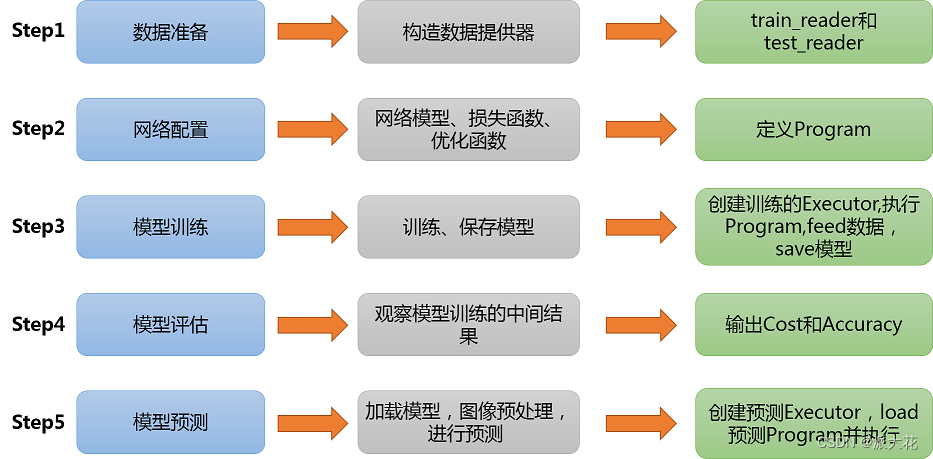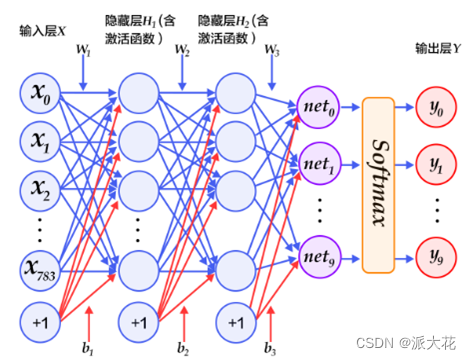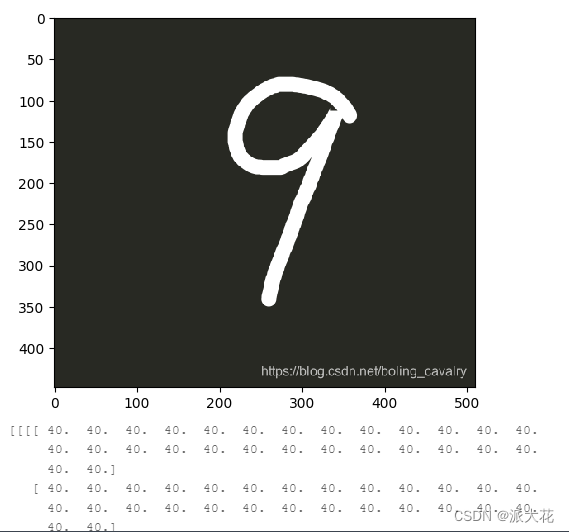
首先导入必要的包:
numpy---------->python第三方库,用于进行科学计算
PIL------------> Python Image Library,python第三方图像处理库
matplotlib----->python的绘图库 pyplot:matplotlib的绘图框架
os------------->提供了丰富的方法来处理文件和目录
#导入需要的包
import numpy as np
import paddle as paddle
import paddle.fluid as fluid
from PIL import Image
import matplotlib.pyplot as plt
import os
from paddle.fluid.dygraph import LinearStep1:准备数据
(1)数据集介绍
MNIST数据集包含60000个训练集和10000测试数据集。分为图片和标签,图片是28*28的像素矩阵,标签为0~9共10个数字。

(2)train_reader和test_reader
paddle.dataset.mnist.train()和test()分别用于获取mnist训练集和测试集
paddle.batch()表示每BATCH_SIZE组成一个batch
paddle.reader.shuffle()表示每次缓存BUF_SIZE个数据项,并在读取一个数据项前进行随机排序。
(3)打印看下数据是什么样的?PaddlePaddle接口提供的数据已经经过了归一化、居中等处理。
!mkdir -p /home/aistudio/.cache/paddle/dataset/mnist/
!cp -r /home/aistudio/data/data65/* /home/aistudio/.cache/paddle/dataset/mnist/
!ls /home/aistudio/.cache/paddle/dataset/mnist/BUF_SIZE=512
BATCH_SIZE=128 #每次流中可以获取的数据量
#用于训练的数据提供器,每次从缓存的数据项中随机读取批次大小的数据
train_reader = paddle.batch(
paddle.reader.shuffle(paddle.dataset.mnist.train(),
buf_size=BUF_SIZE),
batch_size=BATCH_SIZE)
#用于训练的数据提供器,每次从缓存的数据项中随机读取批次大小的数据
test_reader = paddle.batch(
paddle.reader.shuffle(paddle.dataset.mnist.test(),
buf_size=BUF_SIZE),
batch_size=BATCH_SIZE)
#用于打印,查看mnist数据
train_data=paddle.dataset.mnist.train();
sampledata=next(train_data())
print(sampledata)Step2.网络配置
以下的代码判断就是定义一个简单的多层感知器,一共有三层,两个大小为100的隐层和一个大小为10的输出层,因为MNIST数据集是手写0到9的灰度图像,类别有10个,所以最后的输出大小是10。最后输出层的激活函数是Softmax,所以最后的输出层相当于一个分类器。加上一个输入层的话,多层感知器的结构是:输入层-->>隐层-->>隐层-->>输出层。

# 定义多层感知器
#动态图定义多层感知器
# TO DO:修改网络结构,提升性能
class multilayer_perceptron(fluid.dygraph.Layer):
def __init__(self):
super(multilayer_perceptron,self).__init__() #从父类继承属性
#输入为28*28的图像,输出该图像的100个特征点,使用relu函数作为激活函数
#fc1,fc2相当于一个过滤器
self.fc1 = Linear(input_dim=28*28, output_dim=100, act='relu')
self.fc2 = Linear(input_dim=100, output_dim=100, act='relu')
#最后一层过滤得到的是10*1的概率矩阵,值的大小即为概率的大小,概率最大的值所在下标即是答案
self.fc3 = Linear(input_dim=100, output_dim=10,act="softmax")
def forward(self,input_):
x = fluid.layers.reshape(input_, [input_.shape[0], -1])
x = self.fc1(x)
x = self.fc2(x)
y = self.fc3(x)
return y展示模型训练曲线。
all_train_iter=0
all_train_iters=[]
all_train_costs=[]
all_train_accs=[]
#绘制训练过程
def draw_train_process(title,iters,costs,accs,label_cost,lable_acc):
plt.title(title, fontsize=24)
plt.xlabel("iter", fontsize=20)
plt.ylabel("cost/acc", fontsize=20)
plt.plot(iters, costs,color='red',label=label_cost)
plt.plot(iters, accs,color='green',label=lable_acc)
plt.legend()
plt.grid()
plt.show()
def draw_process(title,color,iters,data,label):
plt.title(title, fontsize=24)
plt.xlabel("iter", fontsize=20)
plt.ylabel(label, fontsize=20)
plt.plot(iters, data,color=color,label=label)
plt.legend()
plt.grid()
plt.show()Step3.模型训练并评估
训练需要有一个训练程序和一些必要参数,并构建了一个获取训练过程中测试误差的函数。必要参数有executor,program,reader,feeder,fetch_list。
#用动态图进行训练
all_train_iter=0
all_train_iters=[]
all_train_costs=[]
all_train_accs=[]
best_test_acc = 0.0
with fluid.dygraph.guard():
model=multilayer_perceptron() #模型实例化
model.train() #训练模式
opt=fluid.optimizer.Adam(learning_rate=fluid.dygraph.ExponentialDecay(
learning_rate=0.001 , decay_steps=4000,
decay_rate=0.1,
staircase=True), parameter_list=model.parameters())
epochs_num=20 #迭代次数
#一般来的,跌打次数越多,精度越高
for pass_num in range(epochs_num):
lr = opt.current_step_lr()
print("learning-rate:", lr)
for batch_id,data in enumerate(train_reader()):
images=np.array([x[0].reshape(1,28,28) for x in data],np.float32)
labels = np.array([x[1] for x in data]).astype('int64')
labels = labels[:, np.newaxis]
image=fluid.dygraph.to_variable(images)
label=fluid.dygraph.to_variable(labels)
predict=model(image)#预测
#print(predict)
loss=fluid.layers.cross_entropy(predict,label)
avg_loss=fluid.layers.mean(loss)#获取loss值
acc=fluid.layers.accuracy(predict,label)#计算精度
avg_loss.backward()
opt.minimize(avg_loss)
model.clear_gradients()
all_train_iter=all_train_iter+256
all_train_iters.append(all_train_iter)
all_train_costs.append(loss.numpy()[0])
all_train_accs.append(acc.numpy()[0])
if batch_id!=0 and batch_id%50==0:
print("train_pass:{},batch_id:{},train_loss:{},train_acc:{}".format(pass_num,batch_id,avg_loss.numpy(),acc.numpy()))
with fluid.dygraph.guard():
accs = []
model.eval()#评估模式
for batch_id,data in enumerate(test_reader()):#测试集
images=np.array([x[0].reshape(1,28,28) for x in data],np.float32)
labels = np.array([x[1] for x in data]).astype('int64')
labels = labels[:, np.newaxis]
image=fluid.dygraph.to_variable(images)
label=fluid.dygraph.to_variable(labels)
predict=model(image)#预测
acc=fluid.layers.accuracy(predict,label)
accs.append(acc.numpy()[0])
avg_acc = np.mean(accs)
if avg_acc >= best_test_acc:
best_test_acc = avg_acc
if pass_num > 10:
fluid.save_dygraph(model.state_dict(),'./work/{}'.format(pass_num))#保存模型
print('Test:%d, Accuracy:%0.5f, Best: %0.5f'% (pass_num, avg_acc, best_test_acc))
fluid.save_dygraph(model.state_dict(),'./work/fashion_mnist_epoch{}'.format(epochs_num))#保存模型
print('训练模型保存完成!')
print("best_test_acc", best_test_acc)
draw_train_process("training",all_train_iters,all_train_costs,all_train_accs,"trainning cost","trainning acc")
draw_process("trainning loss","red",all_train_iters,all_train_costs,"trainning loss")
draw_process("trainning acc","green",all_train_iters,all_train_accs,"trainning acc") Step4.模型预测
(1)图片预处理
在预测之前,要对图像进行预处理。
首先进行灰度化,然后压缩图像大小为28*28,接着将图像转换成一维向量,最后再对一维向量进行归一化处理。
def load_image(file):
im = Image.open(file).convert('L') #将RGB转化为灰度图像,L代表灰度图像,像素值在0~255之间
im = im.resize((28, 28), Image.ANTIALIAS) #resize image with high-quality 图像大小为28*28
im = np.array(im).reshape(1, 1, 28, 28).astype(np.float32)#返回新形状的数组,把它变成一个 numpy 数组以匹配数据馈送格式。
print(im)
im = im / 255.0 * 2.0 - 1.0 #归一化到【-1~1】之间
return im
(2)使用Matplotlib工具显示这张图像并预测。
infer_path='/home/aistudio/data/data2304/infer-9.png'
img = Image.open(infer_path)
plt.imshow(img) #根据数组绘制图像
plt.show() #显示图像
label_list = [
"0", "1", "2", "3", "4", "5", "6", "7","8", "9","10"
]
#构建预测动态图过程
model_path = './work/11'
with fluid.dygraph.guard():
model=multilayer_perceptron()#模型实例化
model_dict,_=fluid.load_dygraph(model_path)
model.load_dict(model_dict)#加载模型参数
model.eval()#评估模式
infer_img = load_image(infer_path)
infer_img=np.array(infer_img).astype('float32')
infer_img=infer_img[np.newaxis,:, : ,:]
infer_img = fluid.dygraph.to_variable(infer_img)
result=model(infer_img)
print("infer results: %s" % label_list[np.argmax(result.numpy())])(3)运行部分截图如下:























 2万+
2万+

 被折叠的 条评论
为什么被折叠?
被折叠的 条评论
为什么被折叠?








